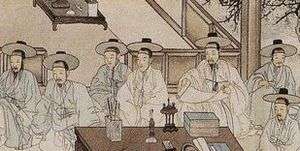Korean theatre
 |
| Part of a series on the |
| Culture of Korea |
|---|
| History |
|
Music and performing arts |
|
|
Monuments |
|
National symbols of Korea |
|
Korean theatre is theatre performances done on stage. It is performed in the Korean language and is generally made up of those of Korean descent. Rising to prominence in ancient Korea, Korean theatre remains vibrant today and is now gaining popularity around the world.
Korean theatre before the 20th century was more 'performance' than 'drama'. There was no plot driven drama, and all the performative presentations, including dance, shaman ritual, and circus were called Nolum (놀음) or Yeonhee (연희), which means 'playing'.
Up till the 19th century the leading form of Korean public theatre was Talchum (탈춤) and Pansori (판소리). Talchum literally means mask-dance. Multiple players wearing masks performed a loosely fixed text through dance, dialogue and song. Since the performers were able to conceal their identities, many of the plays that were played were satires. Pansori is a form of storytelling. There is one central performer who, through dialogue and song goes through a whole story, and another performer who adds rhythm and mood to the story by beating on a drum and putting in verbal sounds (‘chuimsae’-추임새). Neither Talchum nor Pansori had a fixed script – they were handed down orally from generation to generation.
After Korea opened its doors to the foreign countries in late 19th century, the first modern indoor theater, Hyopyul-sa(협률사) was built in 1902, and the ‘new plays’ (신극) started to come through. ‘New plays’ was the term Korean thespians used for the Western drama at that time. The proscenium stage was introduced as well as Shakespeare, and there was a movement among the theatre practitioners to define a line between the traditional Korean theatre and the new wave. Nowadays the traditional forms are continued by the "living national treasures"; people who are selected by the government for having exceptional skill in a traditional art and are funded to pass it down.
Contemporary Korean theatre has three main directions. First there are the government funded theatres such as The National Theatre and Seoul Performing Arts Center. The main repertory consists of Korean traditional theatre and classics such as Shakespeare and Chekhov. The second direction happens at Daehakro (대학로), the ‘off-Broadway’ or ‘off-off-Broadway’ of Seoul, Korea. Most of the theatre that takes place in Daehakro is independent and experimental. The last but largest direction is that of the popular theatre. Many corporate companies have built big theatre spaces in Seoul that are mainly used to stage big musicals and translations of Broadway hits. But whereas these three categories can give one an idea about contemporary Korean theatre, one also needs to keep in mind that the three often intermingle, so sometimes you find experimental theatre at a corporate theatre and a Broadway musical on Daehakro. Korean theatre has spread across the world and is rising to prominence in other countries such as Australia, U.S.A and England. Oftentimes themes include modernized and revised versions of traditional Korean plays mixed with melodrama.